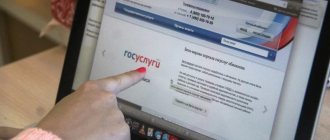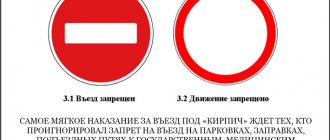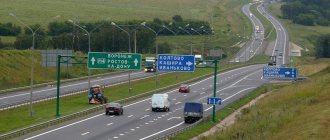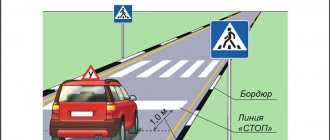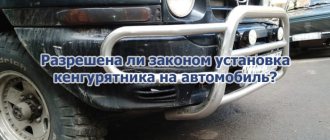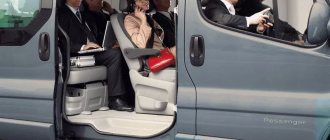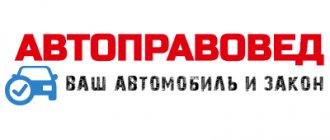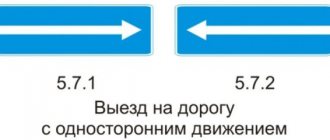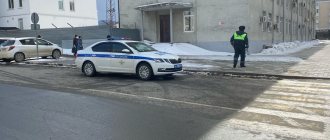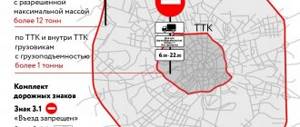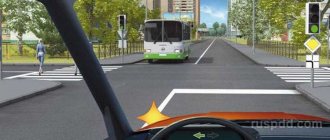“What were you fined for? I drove onto a brick!” - such or similar dialogues can often be heard from drivers, especially if they do not have much driving experience. And everything seems to be obvious: there is a “Brick” sign, it prohibits entry into the territory it is closing, and violation of this requirement leads to a fine.
The greater the surprise of motorists when it turns out that in some conditions they are fined for a relatively small amount of 500 rubles for this sign, and in others they are deprived of their rights. Moreover, there are cases when entry under the “Brick” is possible without any sanctions at all, and will not constitute a violation. We’ll talk about all the details of driving under sign 3.1 “No Entry” in this article.
- Is it possible to pass by public transport?
- When is it installed?
What does the “Brick” sign mean in the traffic rules?
Let’s say right away that “Brick” is an unofficial, one might say popular name for sign 3.1, which is correctly called “No Entry”. However, this colloquial form has become so firmly established in everyday life that it is easily used at all levels - from drivers to traffic police officers and/or judges.
And yet, according to the rules:
Sign 3.1 “Entry prohibited” - prohibits the entry of any vehicle in the direction blocked by this road sign.
Some of the difficulties are already concentrated in this formulation. Are the concepts of “entry” and “travel” different? Why is it stated that the sign applies to all vehicles, if previously it was said that it was possible to drive under the sign with impunity? We'll tell you about all this in due time. For now, let's return to the sign itself.
What does road sign 3.1 “No Entry” look like?
“No Entry” is a round red prohibitory sign with a white rectangle horizontally located in the center of the sign. Actually, this rectangle became the reason to call the sign “Brick”.
See the picture of the sign below.
Brick sign - exceptions
Like most road signs, the “No Entry” sign also has exceptions. True, the range of its exceptions is not very diverse - in fact, its effect does not apply only to vehicles transporting people along established routes (drivers of buses/trolleybuses/trams and similar vehicles can relax).
In other words, even the tenant of the house, at the entrance to whose territory a sign 3.1 is installed, should not escape a penalty in case of violation of the ban on entry established by the “brick”.
Of course, there are other exceptions, but they are of a private nature. Often, various organizations place a “No entry” sign at their gates, in addition to hanging a clarifying sign. For example, “brick” with a postscript, “except for bank cars.” It is logical that only the bank’s vehicle – a collection vehicle, for example – will have the right to enter the bank’s territory.
How is it different from a “No Traffic” sign?
Probably, when talking about differences, they do not mean external manifestations, but just in case, let us remind you what these signs look like next to each other:
On the left in the photo there is a “No Entry” sign, on the right there is a “No Traffic” sign.
But the main thing is the essence of the legal differences. You can often find information that “Brick” prohibits travel in one specific direction, and sign 3.2 blocks traffic in both. On the one hand, this is true, but on the other hand, is adjusting the oncoming flow of much importance for the driver in ordinary practice?
Still, more detailed differences are concentrated in the exceptions that give the right to pass under this sign. We will talk more about the “Brick” later, and we will talk about sign 3.2 in detail later in this article.
Temporary "No Overtaking" sign - what is its coverage area?
The area of validity of temporary sign 3.20, that is, made on a yellow background instead of white, is no different from the similar effect of a permanent sign. Similarly, the validity of a sign may end with another corresponding sign, the distance of the coverage area indicated on the sign, or an intersection or sign of a populated area.
It should be borne in mind that temporary traffic signs have an advantage over permanent ones. What's all this for? Sometimes on the road you may come across, for example, a sign for the end of the no-overtaking zone and literally a meter away from it a temporary yellow sign 3.20, or even these signs will be installed on the same pole. In this case, the yellow sign takes precedence over the white sign and overtaking is still prohibited.
Temporary sign 3.20 “Overtaking is prohibited”
Exceptions, in which cases and who can go under the “Brick”
Let's move on to the most interesting part - who can freely drive under the "Brick"? More precisely, under what conditions will entry under this sign not constitute a violation.
Is it possible to pass by public transport?
Unfortunately, there are not many exceptions, and most of them apply only to route transport engaged in the transportation of passengers:
Public transport may be allowed to enter “Brick” if it follows from its accompanying documents that the area limited by sign 3.1 is included in its permanent route. Passenger taxis do not belong to this category.
Special plates
Other exceptions are possible if they are expressly indicated on the sign below the sign. For example, “except for clients (such and such, etc. Of course, the fact of belonging to the category of exceptions must be documented.
Urgent necessity
Article 2.7 of the Code of Administrative Offenses of the Russian Federation establishes that events committed in conditions of extreme necessity cannot be recognized as an administrative offense.
On the one hand, this means that “if you really need it, then you can,” but on the other hand, it is almost impossible to prove extreme necessity without involving a lawyer.
Common mistakes
It is with the incorrect interpretation of exceptions that violations are most often associated. It is erroneously believed that the adjacent territory, limited by the “Brick”, allows entry to residents. Or employees of enterprises whose nearby territory is limited to entry by sign 3.1. It's a delusion .
If the situation does not fall under one of the above exceptions, driving under the sign is prohibited. This will be a violation, regardless of place of residence or work.
What exceptions are provided in the traffic rules for “Brick”
Unlike sign 3.2, which completely prohibits movement in the area where it was installed, 3.4 has many exceptions. And today this list includes the following drivers or representatives of certain categories:
- Residents of apartment buildings, the adjacent territory of which is limited to “Brick”.
- Vehicles transporting employees of enterprises or individuals along a route that runs through this section of the route.
- Vehicles belonging to the post office, provided that their body is blue with a white diagonal stripe.
- Vehicles owned or servicing businesses and organizations located outside the sign in question.
- Personal vehicles of employees of such enterprises or serving their transportation.
- Equipped cars driven by disabled people of the first and second groups, as well as transport serving this category of citizens and disabled children. It is noteworthy that in all cases, without exception, special yellow stickers with the image of a person in a wheelchair must be pasted on cars.
Private persons in their own cars without disabilities are prohibited from entering the “Brick”.
And at present there are no concessions or good reasons that could make at least some adjustments to this ban.
What is the penalty for driving under the “Brick” sign?
Sanctions for violation are different and directly depend on the place and method of installation of the “Brick”, as well as on the signs accompanying it. Therefore, first we will talk about situations in which sign 3.1 may appear.
When is it installed?
The most common cases of installing a prohibition sign 3.1:
- Restrictions on entry into any territory (for example, into a yard). "Brick" can be installed without additional signs.
- By prohibiting entry into lanes allocated for public transport. Must be accompanied by additional markings or signs.
- Prohibiting entry into oncoming traffic. Accompanied by markings and a permit sign indicating an alternative direction in which traffic is permitted.
- For one-way traffic, prohibiting passage against the direction of flow. Signs confirming one-way traffic are installed at the same time as Brick.
In addition, there is a penalty for repeated violations, but it is not applicable in all cases.
Fine for driving under "Brick"
In accordance with the place and meaning of the sign, the penalties vary:
| Situation | Article of the Code of Administrative Offenses of the Russian Federation | What will happen? |
| Entry under the sign (without oncoming traffic and other conditions listed below) | Part 1 Article 12.16 | From a warning to a fine of 500 rubles. |
| Entering the public transport lane | art.12.17 | The fine is 1,500 rubles, and for Moscow and St. Petersburg – 3,000 rubles. |
| Violation of an oncoming sign | Art.12.15 | Maximum penalty: a fine of 5,000 rubles or deprivation of rights for 4–6 months. |
| Exit to one-way traffic under "Brick" | Part 3 Article 12.16 | A fine of 5,000 rubles or deprivation of driver's license for 4 to 6 months. |
| Repeatedly entering the oncoming lane | Part 3.1 Article 12.16 | If caught by cameras - a fine of 5,000 rubles. When drawing up a traffic police resolution - deprivation of rights for up to 1 year. |
Is it possible to pay with a discount?
Repeated entry into oncoming traffic (Part 3.1, Article 12.16 of the Code of Administrative Offenses of the Russian Federation) is not subject to a 50% payment. The rest can be paid at a discount if repaid within 20 days. Reasons: Part 1.3. Article 32.2 of the Code of Administrative Offences.
Is deprivation of rights possible?
Yes, and this has already been said above. Let us repeat that deprivation of rights from four months to six months is possible in the following cases:
- Driving under “Brick” into oncoming traffic.
- Pass under a sign on a one-way road in the opposite direction to the permitted one.
- Repeated violation related to driving into oncoming traffic.
Let us remind you that deprivation of rights is the maximum possible punishment, which can be replaced by a fine.
In what cases, except for sign 3.20, is overtaking prohibited?
We know that it is not only sign 3.20 that may prohibit overtaking. In 2021, there are a number of cases when overtaking other vehicles is prohibited. At the same time, please note that according to traffic rules, YOU begin overtaking when you begin to enter the left lane (and do not turn on the left turn signal or turn the steering wheel to the left, as some drivers mistakenly believe). Section 11 of the Traffic Regulations is responsible for such a prohibition. So, overtaking is prohibited:
- if someone in front or behind is already overtaking you or other vehicles;
- if someone driving ahead turns on the left turn signal;
- when the driver is not convinced that overtaking is safe, and is also not convinced that after overtaking he will be able to freely return to his lane;
- at intersections with traffic lights or traffic controllers, as well as at unregulated intersections if you are not moving on the main road;
- at pedestrian crossings;
- 100 meters before the railway crossing and directly at the railway crossing itself;
- on and under bridges, overpasses, interchanges and in tunnels;
- on roads with limited visibility and at the end of slopes (although on such sections of the road there is a “No Overtaking” sign).
Remember that according to the traffic rules, based on the above, overtaking by a “locomotive” and double overtaking, when you overtake someone who is already overtaking, creating three rows of cars, are prohibited.
Who can be fined for a “No Trespassing” sign?
All types of offenses can be recorded by traffic police officers. Some passages to "Brick" can be installed using automatic control devices (cameras). Wherein:
- A traffic police officer has the right to draw up a resolution and record an offense, however, deprivation of the right to drive a vehicle is solely within the powers of the court.
- If a violation of sign 3.1 is detected by cameras, only a fine can be applied .
A fine and deprivation of rights are alternative punishments, and under the articles in question should not be applied simultaneously. However, in addition to non-compliance with the “No Entry” sign, other traffic rules may be violated at the same time, then sanctions can be applied in aggregate.
Grounds for appealing entry under a “No Entry” sign
Any erroneous decision can be challenged. The reasons for this may include the following factors:
- The driver is one of the exceptions, whose passage under the “Brick” is not a violation.
- As a special case of the previous one, the sign under the sign gave the driver the right of passage, but this fact was not taken into account when drawing up the resolution.
- Procedural norms were violated when recording a violation.
- The sign was installed with violations and cannot be considered valid.
The final point is the most difficult to prove. Violation of norms F3 No. 196 and/or GOST 52289-2004 must be substantiated. The claims are justified. It is almost impossible for an unprepared driver to do this without the help of a car lawyer. In principle, this applies to other points as well.
Area of operation of the “No Entry” sign
In the current traffic rules there is no precisely established footage of the validity of sign 3.1. The area of his responsibility can be deduced using the accompanying rules. The main ones:
- Between intersections.
- The entire length of the one-way road is in the opposite direction.
- Throughout the entire isolated territory, at the entrance to which a “Brick” is installed.
The effect of the sign begins immediately after the place where it is installed, unless otherwise clearly indicated on the accompanying plate. Thus, moving behind the sign is prohibited, and there is no permissible number of meters that can be driven under the sign .
Finally, we’ll tell you how to consult with a lawyer for free about driving under the “Brick” or other issues.
For a free first consultation, simply formulate and post your question using the form below. Next, the system will determine the most suitable lawyer (by specialty and geography) and transfer the request to him. A response will be formulated and sent.
Further, if the parties decide to cooperate, our system will remove itself from the process, and the car lawyer and the client will continue to communicate directly with each other.
Signs 4.2.1 - 4.2.3 “Avoiding obstacles”
“Avoid Obstacles” signs are used to indicate the directions to bypass the beginning of barriers installed along the axis of the roadway, to indicate the detour of the beginning of the dividing strip, raised traffic islands and guide islands, as well as various kinds of obstacles on the roadway.
Detour directions are indicated by arrows on the signs. A detour is permitted from the direction indicated by the arrow. Road sign 4.2.1 “Avoiding an obstacle on the right” indicates that avoiding an obstacle on the roadway is permitted on the right.
Road sign 4.2.2 “Avoiding an obstacle on the left” indicates that avoiding an obstacle on the roadway is permitted on the left.
Road sign 4.2.3 “Avoiding an obstacle on the right or left” indicates that avoiding an obstacle on the roadway is permitted both on the right and on the left, i.e. from any side.
“Avoid obstacles” signs are installed outside the roadway at the beginning of dividing strips, islands and fences. If there are cabinets with internal lighting in the indicated places, these signs are installed on it. The “Avoid obstacles” signs do not have a coverage area as such; they only indicate from which side detour is permitted.
Rules for installing a sign
The beginning of the sign.
The sign is installed directly in front of the section of the road on which the restriction is imposed.
Begins to operate from the place where the sign is installed.
The effect of the sign extends to the intersection of roadways in front of which the sign is installed.
End of the sign.
The coverage area extends to the current intersection of roadways
Who does the sign not apply to?
The signs do not apply to:
- vehicles with the exception of special vehicles with blue and red flashing lights turned on
